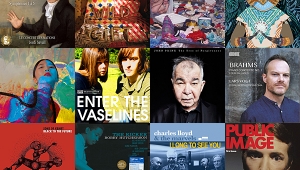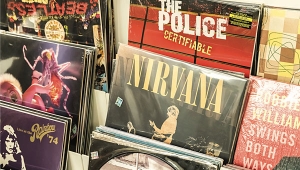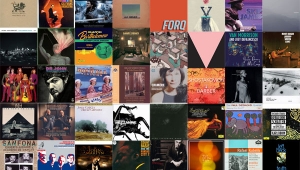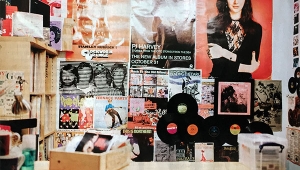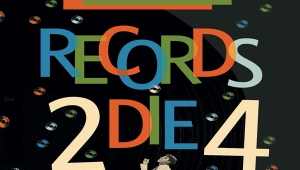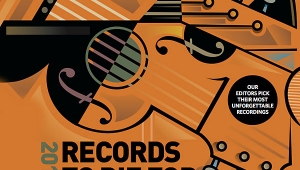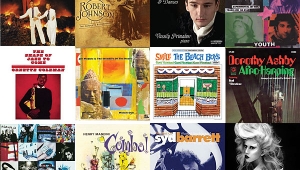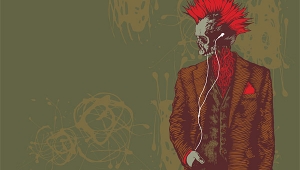| Columns Retired Columns & Blogs |
2006 Records To Die For Page 7
ROBERT J. REINA
KRAFTWERK: Minimum/Maximum
EMI ASW 60611 (2 CDs). Ralf Hutter, Florian Schneider, prods.; Fritz Hilpert, Henning Schmitz, engs. DDD. TT: 2:00:51
LEWIS TAYLOR: Stoned
Hacktone/Shout! Factory DK 37422 (CD). 2005. David Gorman, Michael Nieves, Lewis Taylor, Sabrina Smyth, prods.; Randy Perry, remastering. AAD. TT: 59:13
MAHLER: Symphony 1, Lieder eines fahrenden Gesellen
Christofer Maltman, baritone; Benjamin Zander, Philharmonia Orchestra
Telarc 2SACD-60628 (2 SACDs). 2005. Elaine Martone, David St. George, prods.; Jack Renner, eng. DDD. TT: 68:33 (plus 79:06 discussion disc)
DRIVE-BY TRUCKERS: The Dirty South
New West 6058 (CD). 2004. David Barbe, prod. and eng. AAD. TT: 70:42
? AND THE MYSTERIANS: The Best of ? and the Mysterians: Cameo Parkway 1966–1967
ABKCO 18771-92322 (CD). 1966–67/2005. Neil Bogart, Bob Reno, Beau Gentry, Ritchie Cordell, original prods.; Gregg Geller, Jody H. Klein, Teri Landi, reissue prods.; Bill Cooper, eng.; Bob Ludwig, mastering. AAD. TT: 67:58
KRAFTWERK: Minimum/Maximum
EMI ASW 60611 (2 CDs). Ralf Hutter, Florian Schneider, prods.; Fritz Hilpert, Henning Schmitz, engs. DDD. TT: 2:00:51
This group of fastidious German electronic composers influenced the development of hip-hop, house, and other electronic dance forms. They have now released this two-CD document of highlights from their 2005 world tour. Their best material of the last 30 years has been rearranged and remixed to take advantage of the state of the art of digital synthesis and sound manipulation, and the maturity and subtlety of these arrangements in most cases beat the originals. And the sound, considering the material is almost exclusively digitally synthesized, is breathtaking—as it was in the live show I caught in New York. What's missing are the perfectly synchronized visuals that accompanied the music in concert. You'll have to wait for the DVD for that.
TOM WAITS: Real Gone
Anti 88678-2 (CD). 2004. Tom Waits, prod.; Mark Howard, Gavin Lurssen, engs. AAD? TT: 72:09
In Tom Waits' latest, he's conjured up the usual skid-row images of circus performers in Sheboygan toting bottles of Four Roses and tattoos made with cassette motors. What's new are the bizarre and intoxicating arrangements. Just when you get comfortable, Waits throws in an extra measure or a new time signature to unsettle you. He revels in unorthodox rhythmic constructs, abandoning traditional trap sets for loops of Waits shouting, or substituting a deep inhalation through his nose for a hi-hat. His growly, guttural voice is subtly distorted using an elaborate chain of audiophile microphones, tube electronics, and cheap boom boxes. Best of all, guitarist Mark Ribot finds a different dirty sound for each tune that perfectly complements Waits' voice. This puppy has been on permanent replay in my car for more than a year now.
CRAIG ROSEBERRY
LEWIS TAYLOR: Stoned
Hacktone/Shout! Factory DK 37422 (CD). 2005. David Gorman, Michael Nieves, Lewis Taylor, Sabrina Smyth, prods.; Randy Perry, remastering. AAD. TT: 59:13
Acclaimed UK soul visionary Lewis Taylor, largely unknown in the US, finally hits these shores with the release of his third studio album, Stoned. This expanded, repackaged US edition offers newcomers a glimpse of Taylor's inimitable honeyed falsetto and undeniably dynamic soundscape, which melds introspective blue-eyed soul, funk, psychedelic rock, and melodic pop, revealing influences by Marvin Gaye, Prince, the Beatles, and the Beach Boys. The album not only showcases Lewis' jaw-dropping range, it highlights the achingly tender narratives and simmering midnight grooves that have attracted such fans as Elton John, David Bowie, the Roots, and Don Was.
KATE BUSH: Aerial
Columbia 82796-97772-2 (2 CDs). 2005. Kate Bush, prod.; Del Palmer, eng., mix. AAD. TT: 77:16
Twelve years after the lackluster The Red Shoes, Kate Bush re-emerges with the breathtaking Aerial. Once again she delivers an intimate, transcendent masterpiece on a par with the opaque, muted lyrical and musical beauty of Hounds of Love and Sensual World. This deeply inspired two-disc set is among the best of Bush's work, and worth every anxious moment spent awaiting her return. Tracks such as "Nocturn," "How to Be Invisible," "King of the Mountain," and the closer, "Aerial," only hint at the collection's subtle grandeur, intricate complexity, and panoramic scope.
KALMAN RUBINSON
MAHLER: Symphony 1, Lieder eines fahrenden Gesellen
Christofer Maltman, baritone; Benjamin Zander, Philharmonia Orchestra
Telarc 2SACD-60628 (2 SACDs). 2005. Elaine Martone, David St. George, prods.; Jack Renner, eng. DDD. TT: 68:33 (plus 79:06 discussion disc)
Rarely have I heard the opening pages of Symphony 1 painted with as much graceful charm, yet so imbued with premonition, as in this latest entry in the Zander-Philharmonia Mahler series. Zander's pacing seems neither leisurely nor brisk, but so right that I've intentionally avoided comparing numerical timings. The inner movements are richly nuanced, with subtle shaping of accents and explication of scoring details. The final movement, the most angst-free in the Mahler canon, is powerful, resolute, and, ultimately, triumphant. The Songs of a Wayfarer may lack the weariness and pain of Fischer-Dieskau and Furtwängler's classic recording, but Maltman and Zander are deeply passionate in their own right, and Maltman sounds eerily like F-D in the softer portions. The sound is outstanding, even for Telarc, with a spacious yet immediate soundstage. The epitome of good multichannel, this sounds like stereo perfected—except for the offstage band! Zander's commentary, on a second, bonus disc, adds to the pleasure and value of this outstanding release.
PROKOFIEV: Alexander Nevsky (Complete Film Music)
Marina Domaschenko, mezzo-soprano; Ernst-Senff-Chor; Rundfunk Sinfonieorchester Berlin, Frank Strobel
Capriccio 71014 (SACD). 2004. Maria Gratzel, Christian Schwalbe, prods.; Wolfram Nehls, Geert Puhlmann, engs. DDD. TT: 55:56
This is Prokofiev's complete score for Eisenstein's film Alexander Nevsky (1938), as rescued and reconstructed by conductor Frank Strobel. It's been months since I bought this disc, and my reaction to it is still "Wow!" Strobel and the Berlin RSO deliver, by turns, romance, drama, and deep tragedy as they dig into all the music cues, many of which have not been heard apart from the original film. Some of the cues are simply shawm fanfares or tolling bells, but all are deliciously vivid. This recording is a sonic blockbuster, with excellent dynamics, solid bass, and a spacious and open presentation. The stage width is tremendous, and a few surround effects from the rear speakers are hair-raising. Depth behind the speakers is only okay, but that and a few lapses in the violins are trivial. This version can't replace Prokofiev's cantata based on the same music, but it's better at conjuring memories of Eisenstein's great film. On its own, it's one of the obligatory acquisitions for lovers of big orchestral sound in multichannel. Bravo!
LELAND RUCKER
DRIVE-BY TRUCKERS: The Dirty South
New West 6058 (CD). 2004. David Barbe, prod. and eng. AAD. TT: 70:42
Ambitious, zealous, emotional, and fueled by Jack Daniels, The Dirty South, like its song about tornadoes, careens randomly across the cultural landscape. Three distinct songwriters tell tall tales of Carl Perkins, John Henry, Buford Puser, bootleggers, WWII vets, and nasty rednecks who "empty out shotgun shells and fill 'em full of black-eyed peas," set to music that ranges from hard metal to country rock. The Truckers will almost make you believe in rock'n'roll again. Their emotional tribute to The Band's Rick Danko and Richard Manuel seals the deal.
SACRED STEEL: Traditional Sacred African-American Steel Guitar Music in Florida
Various artists
Arhoolie 450 (CD). 1997. Robert Stone, prod.; no eng. listed. AAD. TT: 74:29
The original recordings of two Pentecostal sects who traded the organ for a steel guitar in their worship services put American gospel and church music through new filters. The music is familiar, but it's different; shades of blues, Hawaiian and surf music, R&B, small-combo blues, and country-western join the mix of hymns and gospel tunes. Glenn Lee's catchy "Joyful Sounds" inspired The Word, a pop group featuring Robert Randolph, this music's only real crossover artist. The goal is to make the pedal steel sound like the human voice, and nothing does that better than Willie Eason's "Franklin D. Roosevelt, A Poor Man's Friend." "It was sad about Roosevelt," he wails. When he lets loose, the steel guitar cries real tears. (XX1-2)
SCOTT SCHINDER
? AND THE MYSTERIANS: The Best of ? and the Mysterians: Cameo Parkway 1966–1967
ABKCO 18771-92322 (CD). 1966–67/2005. Neil Bogart, Bob Reno, Beau Gentry, Ritchie Cordell, original prods.; Gregg Geller, Jody H. Klein, Teri Landi, reissue prods.; Bill Cooper, eng.; Bob Ludwig, mastering. AAD. TT: 67:58
Most mainstream rock histories unfairly dismiss ? and the Mysterians as a one-hit wonder for their 1966 garage-rock anthem, "96 Tears." But the Mexican-American quintet from Saginaw, Michigan, had a lot more going for it than that iconic tune, and this terrific-sounding 27-track collection finally does belated justice to the band's raw genius. Lead loon ?'s flamboyant swagger is matched by his bandmates' no-nonsense chops and the elemental brilliance of Frank Rodriguez's two-stepping Tex-Mex organ. The 27 tunes included here encompass virtually all of the band's output, plus a pair of early demos, including an embryonic "96 Tears."
THE MOVE: Message from the Country
EMI 30342 (CD). 1971/2005. Roy Wood, Jeff Lynne, prods.; Rob Caiger, reissue prod.; Peter Mew, remastering. AAD. TT: 76:19
Although they were a hit act in the UK, Roy Wood's playfully eccentric combo remains a cult item in America. That's a shame—The Move was one of the psychedelic era's most inventive and original bands, combining infectious songcraft, impish humor, and a wildly eclectic musical sensibility. Message from the Country was their memorable swan song, the band moving toward a heavier, near-orchestral approach, thanks in part to new member Jeff Lynne. Lynne, Wood, and drummer Bev Bevan would soon abandon The Move to launch Electric Light Orchestra, but that band would never equal Message from the Country's bracing sonic rush. This expanded edition augments the album's original ten songs with five non-LP singles, three previously unreleased outtakes, and pristine remastered sound. (XXVII-2)
- Log in or register to post comments

